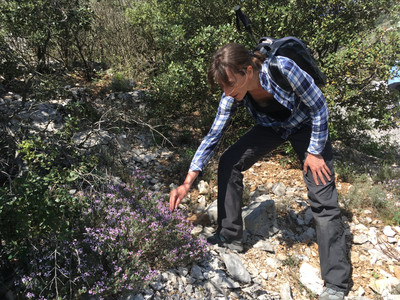An ongoing project on ecological genomics of common thyme (Thymus vulgaris), ERGA-BGE was selected on April 2024 to support the assembly of a chromosome-level genome for T. vulgaris under the call “Enhancing Biodiversity Genomics Applications for Ongoing Case Studies”. This study is led by researchers from Aarhus University in collaboration with researchers from the Center for Evolutionary and Functional Ecology (CNRS and Montpellier University), and builds upon decades of study of the ecological and evolutionary importance of common thyme chemotype diversity.

Close-up view of a flowering thyme plant with the landscape in the background. Photo by Thomas Bataillon
Thyme’s aromatic compounds not only have made it an important culinary and medicinal herb across human cultures, but these compounds also have multiple ecological roles, including defence against herbivore predation, resistance to abiotic stresses such as droughts and freezing and even influencing the species composition of surrounding plant communities. Something that is often not known is that there are multiple thyme scents. Thyme plants exhibit a huge diversity in the aromatic compounds they produce, giving rise to multiple chemotypes. For example, in Mediterranean common thyme it is possible to find up to 7 different chemotypes (scents). These different chemotypes can be broadly classified in two different ecotypes, the phenolic and non-phenolic, which provide adaptation to different habitats. Recent studies in Southern France have shown that the phenolic ecotype, which is better adapted to warm and dry conditions, has been expanding its habitat as a response to on-going climate change.
The current project has produced a genetic dataset of exome sequencing capture of around 1000 thyme plants across different populations in Southern France. Within each population, a transect that captures a gradient of environmental conditions was sampled making sure that samples from both ecotypes were represented within each of the population. Moreover, for each sampling site along the transect, different environmental variables were measured. This design gives the optimal conditions to identify both the genetic variation responsible for ecotype formation and the genetic and environmental drivers of local adaptation. However, genomic analyses have already shown thyme has high genetic diversity, including structural variation involved in ecotype formation. The reference genome will allow better characterisation of thyme genomic landscape and identification of the relevant functional genetic variation and its genomic context. Ultimately, this will improve the management of thyme populations to ensure all of its chemotype diversity can be maintained, thus improving also the health of the Mediterranean ecosystems where thyme is a dominant plant, and help to better understand a so far successful adaptive response to climate change.
Bodil Ehlers with a thyme plant during field work and sampling, view of the landscape of the thyme ecosystem in Southern France. (Photos by Thomas Bataillon)
This work is part of the AromAdapt project funded by an Independent Research Fund Denmark grant awarded to Bodil Ehlers (Principal Investigator) from the Department of Ecoscience, Aarhus University, and Thomas Bataillon (co-PI) from the Bioinformatics Research Center, Aarhus University. The work is done in collaboration with John Thompson and Perrine Gauthier from the Center for Evolutionary and Functional Ecology at CNRS in Montpellier, Sylvain Santoni from the AGAP Institute (INRAE) and Marc Palmada-Flores from Universitat de Girona. This project is funded by the Horizon Europe research and innovation programme, co-funded by the Swiss Government and the British government.
About the Author
Genís Garcia-Erill is a bioinformatician and evolutionary biologist. He is a postdoctoral researcher in Thomas Bataillon´s group in the Bioinformatics Research Center, Aarhus University, Denmark, and he is an ERGA member working in the assembly of the common thyme reference genome.





Comments